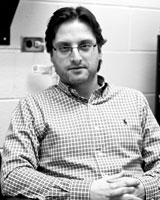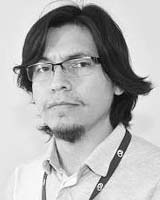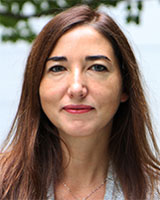New Ideas Grants
2019-2020 New Ideas Project Awardees
Discovering genetic factors that regulate axon regeneration in stem cell derived human neurons
Investigator: Yun Li
Institute: Hospital for Sick Children
Award Value: $75,000
 Damaged neurons in the adult human central nervous system (CNS) do not readily regenerate. This lack of regeneration limits the functional recovery for CNS injuries such as stroke, traumatic brain and spinal cord injuries, multiple sclerosis, infection and other related conditions that involve axon pathology. The lack of ability for human neurons to regrow their axons is a major therapeutic limitation. However, recent animal studies suggest that lack of axon regeneration is the result of intrinsic inhibitory signals (blocking signals) that can be neutralized. These findings raise the exciting prospect that human CNS neurons can be coaxed into regenerating their axons if the inhibitory blockades can be identified and removed. In this project, a genome-wide search for all intrinsic inhibitory factors that prevent axon regeneration will be conducted. This will be accomplished by establishing an in vitro axon injury and regeneration assay using CNS neurons derived from human pluripotent stem cells and will be subjected to a genome-wide CRISPR knockout screen. This project seeks to identify genes which when deleted, allow the human axons to regenerate. This research will establish a genome-wide approach to study the genetic regulation of human axon regeneration, and identify targets for potential therapeutic intervention for a wide spectrum of CNS diseases that involve axon pathology.
Damaged neurons in the adult human central nervous system (CNS) do not readily regenerate. This lack of regeneration limits the functional recovery for CNS injuries such as stroke, traumatic brain and spinal cord injuries, multiple sclerosis, infection and other related conditions that involve axon pathology. The lack of ability for human neurons to regrow their axons is a major therapeutic limitation. However, recent animal studies suggest that lack of axon regeneration is the result of intrinsic inhibitory signals (blocking signals) that can be neutralized. These findings raise the exciting prospect that human CNS neurons can be coaxed into regenerating their axons if the inhibitory blockades can be identified and removed. In this project, a genome-wide search for all intrinsic inhibitory factors that prevent axon regeneration will be conducted. This will be accomplished by establishing an in vitro axon injury and regeneration assay using CNS neurons derived from human pluripotent stem cells and will be subjected to a genome-wide CRISPR knockout screen. This project seeks to identify genes which when deleted, allow the human axons to regenerate. This research will establish a genome-wide approach to study the genetic regulation of human axon regeneration, and identify targets for potential therapeutic intervention for a wide spectrum of CNS diseases that involve axon pathology.
Progressive supranuclear palsy drug target testing using human neurons
Investigator: Yu Lu
Institute: McMaster University
Co-investigators: Karun Singh, McMaster University
Award Value: $75,000
 Progressive supranuclear palsy (PSP) is a neurodegenerative disease affecting mobility, behavior, speech, and thinking. The brain of a PSP patient contains many dead or dying brain cells with internal protein aggregates. The main component of these aggregates is a protein called Tau, which, in a healthy brain, supports vital cell transport systems inside the brain cells. However, Tau aggregates in patients with PSP cause brain cell dysfunction and death. Currently, there is no medication for the core symptoms of PSP.
Progressive supranuclear palsy (PSP) is a neurodegenerative disease affecting mobility, behavior, speech, and thinking. The brain of a PSP patient contains many dead or dying brain cells with internal protein aggregates. The main component of these aggregates is a protein called Tau, which, in a healthy brain, supports vital cell transport systems inside the brain cells. However, Tau aggregates in patients with PSP cause brain cell dysfunction and death. Currently, there is no medication for the core symptoms of PSP.
In our brain cells, the Tau gene encoded in the DNA is first used to make message molecules known as RNA. These Tau RNA molecules go through a process called splicing, during which these RNA molecules are edited. Multiple proteins, many still unknown, control splicing of the Tau RNA molecule. Any mistakes in the levels and functions of these proteins could lead to out-of-control Tau splicing, which is a major cause of Tau aggregate formation and brain dysfunction. Therefore, it is important to develop drugs to tackle the aberrant Tau splicing in PSP. In this study, the objective is to use a human stem cell model to unveil proteins contributing to Tau splicing mistakes in PSP patients. These proteins could represent potential new drug targets to correct Tau splicing and treat PSP.
Treating aberrant brain development associated with congenital muscle disease by sensorimotor stimulation
Investigator: Vince Tropepe
Institute: University of Toronto
Award Value: $73,000
 Congenital myopathies and muscular dystrophies (CMDs) are heterogeneous disorders, many of which have neurodevelopmental co-morbidities. Defects in brain development, such as cerebral hypoplasia, are often considered secondary to the primary muscle disease phenotype. Previous research has discovered that movement is critical for promoting normal brain development (neurogenesis) and growth of the post-embryonic forebrain. Restricting movement caused premature differentiation of neural progenitors and brain dysfunction. Movement-dependent forebrain neurogenesis requires somatosensory feedback from the body. Such a relationship between movement and brain development might explain the known co-morbidity between physical and neurological deficits in congenital muscle diseases (CMDs). We propose to characterize the post-embryonic forebrain growth in established models of CMD and test the possibility of combatting aberrant neurodevelopment by providing sensorimotor input to the brain. To do so, we will characterize the changes underlying neurogenesis leading to a reduction in forebrain growth in selected CMD mutants. Second, we will test if aberrant brain development associated with CMD can be combatted via targeted activation of dorsal root ganglion (DRG) neurons and finally, we will examine whether norepinephrine is a key mediator of sensorimotor dependent forebrain neurogenesis. This research will reveal the neurodevelopmental consequences of CMD and provide novel therapeutic avenues for promoting healthy brain growth in CMD patients.
Congenital myopathies and muscular dystrophies (CMDs) are heterogeneous disorders, many of which have neurodevelopmental co-morbidities. Defects in brain development, such as cerebral hypoplasia, are often considered secondary to the primary muscle disease phenotype. Previous research has discovered that movement is critical for promoting normal brain development (neurogenesis) and growth of the post-embryonic forebrain. Restricting movement caused premature differentiation of neural progenitors and brain dysfunction. Movement-dependent forebrain neurogenesis requires somatosensory feedback from the body. Such a relationship between movement and brain development might explain the known co-morbidity between physical and neurological deficits in congenital muscle diseases (CMDs). We propose to characterize the post-embryonic forebrain growth in established models of CMD and test the possibility of combatting aberrant neurodevelopment by providing sensorimotor input to the brain. To do so, we will characterize the changes underlying neurogenesis leading to a reduction in forebrain growth in selected CMD mutants. Second, we will test if aberrant brain development associated with CMD can be combatted via targeted activation of dorsal root ganglion (DRG) neurons and finally, we will examine whether norepinephrine is a key mediator of sensorimotor dependent forebrain neurogenesis. This research will reveal the neurodevelopmental consequences of CMD and provide novel therapeutic avenues for promoting healthy brain growth in CMD patients.
Generation of heart pacemaker cells from stem cells
Investigator: Stephanie Protze
Institute: University Health Network
Award Value: $75,000
 The human heart rate is controlled by two specialized pacemaker tissues in the heart known as the sinoatrial node (SAN) and the atrioventricular node (AVN). The SAN initiates electrical signals that drive the heartbeat while the AVN is responsible for propagating these electric signals from the upper heart chambers to the bottom heart chambers. This activates their contraction and results in the pumping of blood through the body. Failure of either pacemaker tissue leads to a life-threatening irregular or slow heartbeat and needs to be treated by implantation of an electronic pacemaker device. Approximately 21,000 Canadians receive an electronic pacemaker every year. While representing an effective treatment, electronic pacemakers have a number of disadvantages including the risk of pacemaker lead infections, the need for surgical battery replacements, and the limited adaption to growth in cases of pediatric patients. The ability to replace failing pacemaker tissue with functional pacemaker cells derived from stem cells to generate a biological pacemaker represents an attractive alternative that could overcome these disadvantages. We have previously been successful in generating SAN pacemaker cells from stem cells and have shown that these cells can function as a biological pacemaker in a small animal model. In this study we aim to identify methods to derive AVN pacemaker cells from stem cells and to functionally characterize their pacemaker phenotype. The long-term objective is to use these AVN pacemaker cells in biological pacemaker approaches to provide an improved treatment for patients with AVN pacemaker diseases in Canada and worldwide.
The human heart rate is controlled by two specialized pacemaker tissues in the heart known as the sinoatrial node (SAN) and the atrioventricular node (AVN). The SAN initiates electrical signals that drive the heartbeat while the AVN is responsible for propagating these electric signals from the upper heart chambers to the bottom heart chambers. This activates their contraction and results in the pumping of blood through the body. Failure of either pacemaker tissue leads to a life-threatening irregular or slow heartbeat and needs to be treated by implantation of an electronic pacemaker device. Approximately 21,000 Canadians receive an electronic pacemaker every year. While representing an effective treatment, electronic pacemakers have a number of disadvantages including the risk of pacemaker lead infections, the need for surgical battery replacements, and the limited adaption to growth in cases of pediatric patients. The ability to replace failing pacemaker tissue with functional pacemaker cells derived from stem cells to generate a biological pacemaker represents an attractive alternative that could overcome these disadvantages. We have previously been successful in generating SAN pacemaker cells from stem cells and have shown that these cells can function as a biological pacemaker in a small animal model. In this study we aim to identify methods to derive AVN pacemaker cells from stem cells and to functionally characterize their pacemaker phenotype. The long-term objective is to use these AVN pacemaker cells in biological pacemaker approaches to provide an improved treatment for patients with AVN pacemaker diseases in Canada and worldwide.
Development of decellularized scaffolds for intervertebral disc repair and regeneration
Investigator: Lauren Flynn
Institute: Western University
Co-investigators: Cheryle Séguin, Western University
Award Value: $75,000
 Chronic back pain associated with intervertebral disc degeneration is a debilitating condition that negatively impacts the quality of life of many Canadians. Current treatment strategies focusing on pain management or surgical intervention have limited efficacy and can lead to numerous complications. Cell-based therapies involving the delivery of pro-regenerative stem cells into the intervertebral disc (IVD) hold promise as a new approach to modify the progression of the disease and promote constructive tissue repair, with the goal of improving function and reducing pain. This research project brings together a multidisciplinary research team to develop novel cell-instructive biomaterials for applications in cell delivery to promote IVD regeneration, as well as in advanced models of IVD disease. These biomaterials platforms will be designed to mimic the composition of the human IVD within a naturally-derived polymer that forms a gel at body temperature. Through detailed cell culture studies, the team will explore the proliferation and differentiation of human nucleus pulposus cells and notochord-like stem cells following encapsulation, and will tune the platform to enhance cell viability and lineage-specific differentiation to augment the regenerative potential of the cells. Future studies will extend the approach to generate tissue-specific disease models to develop a better understanding of the cellular changes that occur in IVD degeneration and the impact of the diseased microenvironment on IVD cells. Our platforms will provide much-needed insight into the effects of the local microenvironment on IVD cell function and phenotype and may be applied in future stem cell-based therapies for the treatment of IVD degeneration.
Chronic back pain associated with intervertebral disc degeneration is a debilitating condition that negatively impacts the quality of life of many Canadians. Current treatment strategies focusing on pain management or surgical intervention have limited efficacy and can lead to numerous complications. Cell-based therapies involving the delivery of pro-regenerative stem cells into the intervertebral disc (IVD) hold promise as a new approach to modify the progression of the disease and promote constructive tissue repair, with the goal of improving function and reducing pain. This research project brings together a multidisciplinary research team to develop novel cell-instructive biomaterials for applications in cell delivery to promote IVD regeneration, as well as in advanced models of IVD disease. These biomaterials platforms will be designed to mimic the composition of the human IVD within a naturally-derived polymer that forms a gel at body temperature. Through detailed cell culture studies, the team will explore the proliferation and differentiation of human nucleus pulposus cells and notochord-like stem cells following encapsulation, and will tune the platform to enhance cell viability and lineage-specific differentiation to augment the regenerative potential of the cells. Future studies will extend the approach to generate tissue-specific disease models to develop a better understanding of the cellular changes that occur in IVD degeneration and the impact of the diseased microenvironment on IVD cells. Our platforms will provide much-needed insight into the effects of the local microenvironment on IVD cell function and phenotype and may be applied in future stem cell-based therapies for the treatment of IVD degeneration.
How to make off-the-shelf cellular treatment of diabetic ulcers more effective
Investigator: Sowmya Viswanathan
Institute: University Health Network
Co-investigators: Ian Rogers, Lunenfeld-Tanenbaum Research Institute
Award Value: $75,000
 One of the major complications of diabetes is the alteration of wound healing, which can lead to chronic wounds such as diabetic foot ulcers. Diabetes prolongs the duration of normal wound healing by shifting neutrophil infiltration and monocyte/macrophages polarization towards pro-inflammatory subtypes. Mesenchymal stromal cells (MSCs) are a potential therapeutic option for diabetic wound complications. Recently, MSCs have been utilized for their anti-inflammatory functionality in Crohn’s disease, graft vs. host disease and critical limb ischemia. The Viswanathan lab has developed a novel protocol to enhance MSCs by growing them in scalable 3D suspensions in serum-free medium and proprietary cytokines or small molecules. The 3D configuration alters cell adhesion markers and results in more potent anti-inflammatory and immune modulatory MSCs without licensing or genetic modification. Importantly, the enhanced anti-inflammatory and immunomodulatory properties are maintained through cryopreservation, making 3D enhanced MSCs attractive as an off-the-shelf, ready-to use therapy for acute applications, such as diabetic ulcers. In this project, we will focus on optimizing cryopreservation parameters for 3D configurations of MSCs. Using design-of-experiment statistical approaches, we will systematically optimize combinations of parameters to cryopreserve 3D configurations of MSCs for immediate post-thaw use in a validated diabetic ulcer model in collaboration with the Rogers lab. These studies will provide proof-of-concept data for clinical trial applications using potent, ready-to use MSC products for diabetic wounds.
One of the major complications of diabetes is the alteration of wound healing, which can lead to chronic wounds such as diabetic foot ulcers. Diabetes prolongs the duration of normal wound healing by shifting neutrophil infiltration and monocyte/macrophages polarization towards pro-inflammatory subtypes. Mesenchymal stromal cells (MSCs) are a potential therapeutic option for diabetic wound complications. Recently, MSCs have been utilized for their anti-inflammatory functionality in Crohn’s disease, graft vs. host disease and critical limb ischemia. The Viswanathan lab has developed a novel protocol to enhance MSCs by growing them in scalable 3D suspensions in serum-free medium and proprietary cytokines or small molecules. The 3D configuration alters cell adhesion markers and results in more potent anti-inflammatory and immune modulatory MSCs without licensing or genetic modification. Importantly, the enhanced anti-inflammatory and immunomodulatory properties are maintained through cryopreservation, making 3D enhanced MSCs attractive as an off-the-shelf, ready-to use therapy for acute applications, such as diabetic ulcers. In this project, we will focus on optimizing cryopreservation parameters for 3D configurations of MSCs. Using design-of-experiment statistical approaches, we will systematically optimize combinations of parameters to cryopreserve 3D configurations of MSCs for immediate post-thaw use in a validated diabetic ulcer model in collaboration with the Rogers lab. These studies will provide proof-of-concept data for clinical trial applications using potent, ready-to use MSC products for diabetic wounds.
Collagen-based Capsules for Progenitor-cell Therapies
Investigator: Emilio Alarcon
Institute: University of Ottawa
Co-investigators:
Erik Suuronen, University of Ottawa Heart Institute
Darryl Davis, University of Ottawa Heart Institute
Award Value: $74,814
 Micro-encapsulation of stem cells has proven to be a practical methodology for improving cell engraftment and repair of injured heart muscle. However, to date, most microcapsules have been prepared using inert polymeric matrices and/or synthetic polymeric blends that limit its biodegradability and makes clinical translation difficult. In this project, the team will develop and assess the in vivo performance of a next generation of collagen-based microcapsules for progenitor cell therapies specifically designed to improve capsule retention and biodegradability within injured cardiac (heart) tissue. We hypothesize that micro-engineering the compositional structure of capsules, using medical grade collagen will produce materials with enhanced the length of time the cells are retained at the site of injection and biological activity within infarcted myocardium (tissues damaged by a heart attack). Since the new capsules are cleavable ; this provides a means to deliver stem cells selectively in regions where cardiac functional remodelling is taking place. Thus, our novel materials will open new avenues towards the development of bio-responsive materials for boosting functional engraftment of stem-cells within injured cardiac muscle.
Micro-encapsulation of stem cells has proven to be a practical methodology for improving cell engraftment and repair of injured heart muscle. However, to date, most microcapsules have been prepared using inert polymeric matrices and/or synthetic polymeric blends that limit its biodegradability and makes clinical translation difficult. In this project, the team will develop and assess the in vivo performance of a next generation of collagen-based microcapsules for progenitor cell therapies specifically designed to improve capsule retention and biodegradability within injured cardiac (heart) tissue. We hypothesize that micro-engineering the compositional structure of capsules, using medical grade collagen will produce materials with enhanced the length of time the cells are retained at the site of injection and biological activity within infarcted myocardium (tissues damaged by a heart attack). Since the new capsules are cleavable ; this provides a means to deliver stem cells selectively in regions where cardiac functional remodelling is taking place. Thus, our novel materials will open new avenues towards the development of bio-responsive materials for boosting functional engraftment of stem-cells within injured cardiac muscle.
Characterization of immune cells during human pancreatic development
Investigator: Maria Cristina Nostro
Institute: University Health Network
Co-investigators: Gordon Keller, University Health Network
Award Value: $75,000
 There are two forms of diabetes mellitus: type 1 diabetes (T1D), characterized by the destruction of insulin-producing cells (β cells) by the immune system and type 2 diabetes (T2D), a metabolic disorder that is linked to insulin resistance and β cell failure. Currently, T1D is treated by insulin administration using needle injections or pumps. Patients with T2D are treated with medications that increase insulin secretion from the β cells, reduce sugar production by the liver or enhance insulin sensitivity. Despite these treatments, poorly controlled sugar levels in the blood leads to severe complications, including blindness, limb amputations, kidney failure and cardiovascular diseases. According to Statistics Canada, diabetes mellitus is the 6th leading cause of death in Canada. It is clear that in order to improve these figures, new generations of therapies will be required. The recent progress in stem cell research is bringing us closer to developing β cell therapies for T1D. This proposal leverages on Drs. Nostro and Keller’s expertise on the differentiation of insulin-producing pancreatic β cells and hematopoietic cells. Together, we propose to profile various cell types in the developing human pancreas to identify novel regulatory mechanisms that control β cell maturation and use this information to optimize the production of β cells from human pluripotent stem cells (hPSCs), generating a cell type that has potential for transplantation into patients with T1D.
There are two forms of diabetes mellitus: type 1 diabetes (T1D), characterized by the destruction of insulin-producing cells (β cells) by the immune system and type 2 diabetes (T2D), a metabolic disorder that is linked to insulin resistance and β cell failure. Currently, T1D is treated by insulin administration using needle injections or pumps. Patients with T2D are treated with medications that increase insulin secretion from the β cells, reduce sugar production by the liver or enhance insulin sensitivity. Despite these treatments, poorly controlled sugar levels in the blood leads to severe complications, including blindness, limb amputations, kidney failure and cardiovascular diseases. According to Statistics Canada, diabetes mellitus is the 6th leading cause of death in Canada. It is clear that in order to improve these figures, new generations of therapies will be required. The recent progress in stem cell research is bringing us closer to developing β cell therapies for T1D. This proposal leverages on Drs. Nostro and Keller’s expertise on the differentiation of insulin-producing pancreatic β cells and hematopoietic cells. Together, we propose to profile various cell types in the developing human pancreas to identify novel regulatory mechanisms that control β cell maturation and use this information to optimize the production of β cells from human pluripotent stem cells (hPSCs), generating a cell type that has potential for transplantation into patients with T1D.
2018-2019 Awardees:
- Elucidation of splicing-based mechanisms underlying cell fate control that represent targets in regenerative medicine applications ($75,000). Project Leader: Benjamin Blencowe (University of Toronto)
- A matter of timing: how the circadian clock regulates intestinal regeneration ($75,000). Project Leader: Phillip Karpowicz (University of Windsor)
- Developing new reprogramming strategies for cell replacement therapy of glaucoma ($75,000) Project Leader: Pierre Mattar (Ottawa Hospital Research Institute)
- Making new neurons from resident brain cells: a new therapy for stroke repair? ($74,946) Project Leader: Maryam Faiz (University of Toronto)
- Collaborative laboratory-based study of stem cell therapies: Preclinical Multicenter Acute lung injury Trials In Canada (PreMATIC) ($74,997) Project Leader: Manoj Lalu (Ottawa Hospital Research Institute)
- Boosting cellular energy signals in muscle stem cells as a therapy for muscular dystrophy ($75,000) Project Leader: Keir Menzies (University of Ottawa)
2017-2018 Awardees (*co-funded by Medicine by Design; **Funded by Medicine by Design):
- The impact of environmental pollutants on pancreas development ($75,000) Project Leader: Jennifer Bruin (Carleton University)
- A 3D model of muscle to study potential therapies for Duchenne muscular dystrophy* ($75,000) Project Leader: Penney M. Gilbert (University of Toronto)
- Tailoring donor lungs to control immune response before transplant** ($75,000) Project Leader: Stephen C. Juvet (University Hospital Network)
- Improving the creation of bile duct cells to model liver disease** ($75,000) Project Leader: Binita M. Kamath (SickKids Research Institute)
- A computational modelling platform to support imaging and tissue design** ($75,000) Project Leader: John Parkinson (SickKids Research Institute)
- Understanding radial glial cell response to neural injury at a single cell level** ($75,000) Project Leader: Bret Pearson (SickKids Research Institute)
- A therapeutic strategy for treating Duchenne Muscular Dystrophy ($75,000) Project Leader: Michael A. Rudnicki (Ottawa Hospital Research Institute)
- Magnetic resonance imaging to assess stem cell treatments for lung diseasel** ($75,000) Project Leader: Giles Santyr (SickKids Research Institute)
- Autism spectrum disorder drug testing using human neurons ($75,000) Project Leader: Karun Singh (McMaster University)
- Clinical investigation of cell therapy to treat age-related osteoporosis ($75,000) Project Leader: William L Stanford (Ottawa Hospital Research Institute)
- Making new blood vessels for life-threatening lung diseases in newborns ($75,000) Project Leader: Bernard Thébaud (Ottawa Hospital Research Institute)
- New ways to stimulate the production of insulin-producing cells to treat diabetes* ($75,000) Project Leader: Michael B. Wheeler (University of Toronto)
Past Awardees (*co-funded by Medicine by Design):
- Control of immune tolerance toward allograft cell transplants ($50,000) Project Leader: Andras Nagy (The Lunenfeld-Tanenbaum Research Institute) 2015-16
- Dissolving scar tissue in spinal cord injuries improve candidacy and effects of stem cell transplants* ($49,988) Project Leader: Charles Tator (University Health Network) 2015-16
- Sole fuel source to enhance pluripotency ($50,000) Project Leader: Dean Betts (Western University) 2015-16
- An injectable biomaterial system for the delivery of stem cells in the treatment of retinal disease ($50,000) Project Leader: Heather Sheardown (McMaster University) 2015-16
- Activating enhancers to improve reprogramming efficiency* ($50,000) Project Leader: Jennifer Mitchell (University of Toronto) 2015-16
- Better maturation of iPS-derived heart cells ($49,200) Project Leader: John Coles (SickKids Research Institute) 2015-16
- Protein inactivation by agrochemicals as a mechanism underlying development of Autism Spectrum Disorder ($49,994) Project Leader: John Vessey (University of Guelph) 2015-16
- Injectable, tissue engineered scaffold for delivery of cardiac patches* ($50,000) Project Leader: Milica Radisic (University of Toronto) 2015-16
- Heart tissue repair via immune cell growth factors* ($50,000) Project Leader: Slava Epelman (University Health Network) 2015-16
- Intestinal stem cells and gut microbiota in early postnatal development and necrotizing enterocolitis ($49,980) Project Leader: Tae-Hee Kim* (SickKids Research Institute) 2015-16
- Biomimetic surfaces for directed differentiation of lung stem cells * ($49,983) Project Leader: Tom Waddell (Univerisity Health Network) 2015-16
- Mechanisms regulating differentiation in hemangioma stem cells ($49,500) Project Leader: Zia Khan (Western University) 2015-16
- TIMP-engineered niches for liver progenitor cell expansion ($75,000) Project Leader: Rama Khokha (University Health Network) 2014-15
- Control of RNA translation into proteins in human stem cells, neurons and disease ($75,000) Project Leader: James Ellis (SickKids Research Institute) 2014-15
- Engineering a functional human thymus from pluripotent stem cells ($75,000) Project Leader: Peter Zandstra (University of Toronto) 2014-15
- Role of short RNA fragments in mediating the anti-inflammatory effects of bone marrow stem cells in sepsis ($75,000) Project Leader: Duncan Stewart (Ottawa Hospital Research Institute) 2014-15
- Genomic correction of cardiac sarcomeric protein mutations in iPSC-derived cardiomyocytes ($75,000)Project Leader: John Coles (SickKids Research Institute) 2014-15
